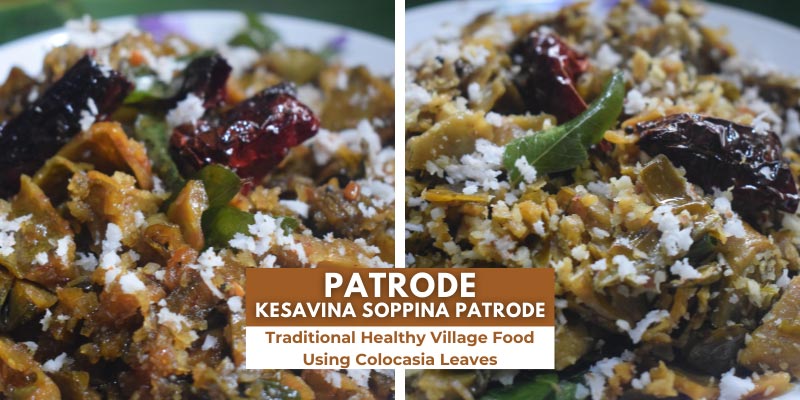
Patrode is one of the traditional and healthy breakfasts in the South. It is a very popular and colourful breakfast. For this there is no need for any side dish. In coastal places this is all peoples favourite recipe. The patrode is a balancing of sweetness, spiciness and tanginess. This style of patrode is also called as konkani style patrode in Mangalore region.
Generally patrode are made with tropical plant known as colocasia leaves, here it is called as kesavina ele. But patrode can make from several vegetables like banana flower, spinach leaves and so on. Here, i have shown in one method of doing patrode from colocasia leaves. The colocasia leaves are very healthy.
For doing this recipe, i have used soaked dosa rice not boiled rice. I added spices for batter like red chilly, coriander, cumin. Adding Jaggery and grated coconut gives nice tastes to the patrode. While doing patrode tamarind is must because colocasia leaves have itching issues. So we need add tamarind well. Otherwise while you are eating patrode starts to itch inside the mouth. To avoid itching necessary to add tamarind.
The patrode batter is not thick and has a flowing consistency. It must be slightly thick to dosa batter. While spreading the batter we should take a large plate or clean the floor. Remove all the veins of leaves. If you do not remove the veins, it will give trouble to roll and itch when you eat the patrode. This type of patrode needs layering, so place one colocasia leaf spread the batter evenly otherwise the roll will not come correctly. After spreading to one, leave the place one by one and spread the batter. For one roll you can use three to four leaves. The layering of the patrode is not complicated one. After layering, fold the side and roll it like thick cylindrical. If the roll is not thick, when it starts to steam the batter will leak.
Serving of patrode.
- After steaming you can cut into rolls and place in tava and spread the oil and have it. Otherwise you can give simple tempering to the patrode with a sweet and unsweetened version.
- Give a simple tempering with oil, urad dal, red chilli and mustard and curry leaves. Add the chopped patrode pieces and mix it with grated coconut.
- Give a simple tempering with oil, urad dal, red chilli and mustard and curry leaves. Mix the grated coconut and jaggery. Add the chopped patrode pieces and mix well.
These three serving are very tasty and delicious. You can try any servings. The patrode has a unique taste. Most people like to have a patrode. Generally people will think patrode is very difficult to prepare. But if you follow the correct procedure it becomes easy to prepare.
I hope you liked this patrode recipe and I will share some tips too for beginners. I was overwhelmed by you for spotting trendy angel kitchens. Stay connected to the next recipes too. I will come up with an interesting recipe.
Health Benefits of Colocasia leaves:
- Prevent cancer: An excellent source of vitamin C, a water-soluble antioxidant, also potent anticancer effects which inhibit the growth of cancerous tumours and lower the progress of cancer cell proliferation.
- Promote eye health: Rich in vitamin A which is essential in keeping your eyes healthy, maintaining good vision and preventing age-related macular degeneration, oroviding clear vision by maintaining a clear cornea.
- Lower high blood pressure: Due to the presence of saponins, tannins, carbohydrate and flavonoids.
- Strengthen immune system: Significant amounts of vitamin C in colocasia leaves help boost your immune system efficiently. Especially the t-cells and phagocytes of the immune system require vitamin C to function properly.
- Prevent diabetes: Antidiabetic activity of the ethanol extract of Colocasia esculenta results in a decrease of blood glucose levels and prevented the loss of body weight.
- Help in digestion: Known to aid in digestion and treat digestive problems because of the presence of dietary fibre which helps in better food digestion and absorption of nutrients. The leaves also support the growth of beneficial microbes such as Escherichia coli and Lactobacillus acidophilus which live peacefully in the intestines, helping in digestion and fighting against harmful microbes.
- Reduce inflammation: The leaves of the colocasia contain phenols, tannins, flavonoids, glycosides, sterols and triterpenoids which contain anti-inflammatory and antimicrobial properties which help in reducing chronic inflammation. The taro leaf extract possesses significant inhibitory effects on histamine and serotonin which are the preformed mediators involved in the initial phase of the acute inflammatory process.
- Protect the nervous system: leaves of the taro contain vitamin B6, thiamine, niacin and riboflavin which are known to protect the nervous system. All of these nutrients aid in the proper development of the foetal brain and strengthening the nervous system. A study showed the effects of hydroalcoholic extract of Colocasia esculenta in obsessive compulsive disorder linked to central nervous system dysfunction.
- Prevent anaemia: Anaemia is a condition which occurs when the body suffers a low haemoglobin count. Taro leaves have a significant amount of iron which aid in the formation of red blood cells. Also, the vitamin C content in taro leaves help in better iron absorption which further lowers the risk of anaemia.
TrendyAngel Kitchen | Vegetarian Food | Healthy, Traditional, Modern, Regional & More.
Like TrendyAngel Kitchen on Facebook: https://www.facebook.com/trendyangelkitchen
Follow TrendyAngel Kitchen Instagram: https://www.instagram.com/trendyangelkitchen
Like, Share & Subscribe on YouTube: https://www.youtube.com/c/TrendyAngelKitchen
All Recipes in TrendyAngel Kitchen Website: https://trendyangel.in/
